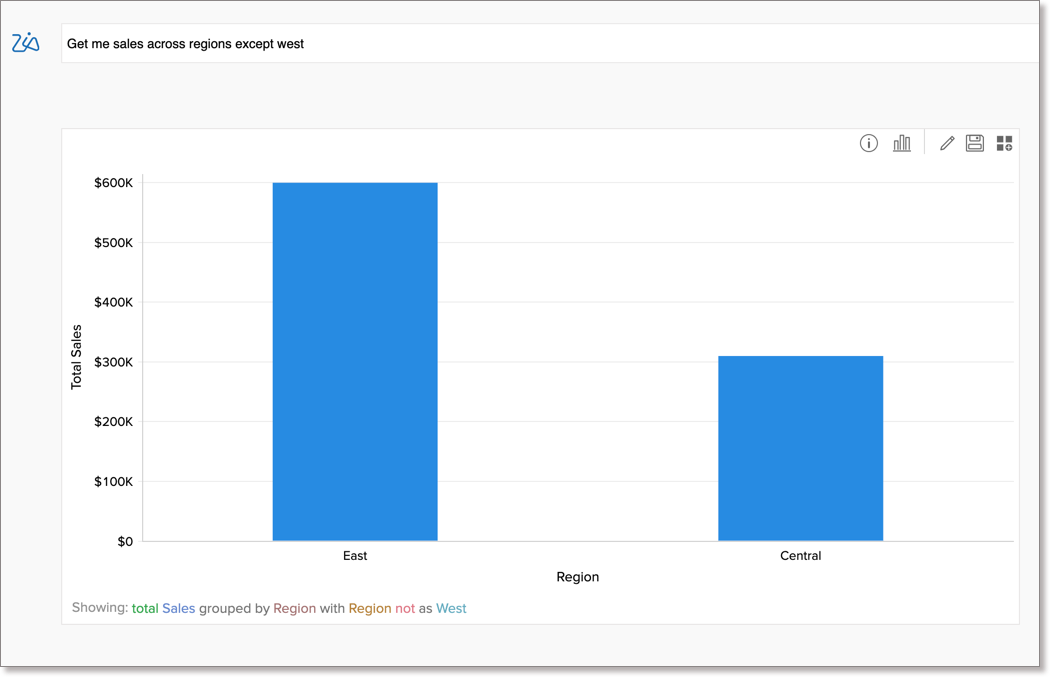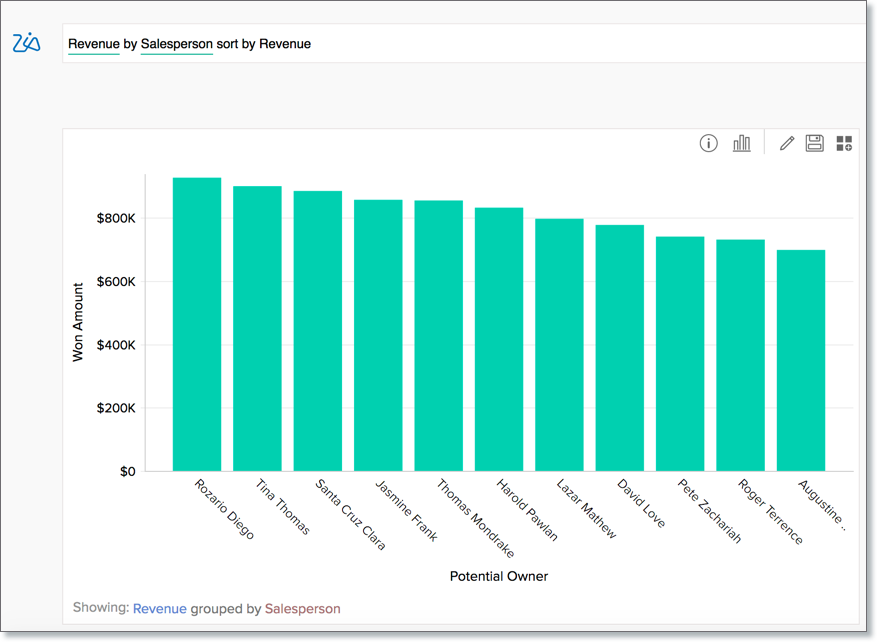Constructing Questions for Ask Zia
You can ask your question to Zia in plain English. Zia will understand your question's intent and will reply with the most appropriate report that matches your question. However, there can be some communication gaps like how it exists among people.
This section explains how best you can communicate with Ask Zia.
How to Construct Questions?
Ask Zia can understand the intent in your questions. It can resolve ambiguity and generate the best possible insights for your questions. The questions you construct can be one of the following types.
Structured Question
Your question can be in a structured language e.g.,
Show me the sales by billing location for the year 2020

Unstructured Question
Your question can be in an unstructured fragment phrase e.g.,
New customer count previous year

WH Questions
You can ask a 'WH' question. Ask Zia recognizes the 'WH' questions such as what, when, who, which e.g.,
What is the total sales last year?

Explicit Information
Your question states explicit information in your data. e.g., Let's say you have Orders and Billing State columns in your dataset. The below question will get the total sales for each region.
Get me the Orders Quantity by Billing State

Implicit Information
Your question contains implicit information. Ask Zia will identify the terms such as monthly, yearly, daily, quarterly. e.g., for the below question, Zia will recognize the term Monthly, identifies a date column in your data set, and plots the sales across months.
Monthly Sales

Column Value
Your question can contain a value from a column. In this case, 2020 is a value in the column Created At. Ask Zia will identify this and includes the data for the year 2020.
Get me the monthly sales of 2020

Across Tables
You can ask for metrics across tables in your dataset. Ask Zia will interpret it based on how you have joined the tables using Lookup column. In this example, the column Customer Name is from the Customers table, the column Product Type is from the Products table, and the column Total Price is from the Orders table.
customer name by product by sales

Formula Columns
You can ask a metric from a formula column available in your dataset.

Typographical Error
Your question can contain a typographical error. Ask Zia can interpret questions with incomplete, incorrect words. In this case, the term 'salse' will be matched with sales
salse by year

What can be achieved in Ask Zia?
Ask Zia supports creating the following types of queries.
Ask for a Metric
You can ask for a single metric or multiple metrics in a question like sales, fulfilled orders, new customers, etc.,
Single Metric
You can ask for a single metric in your question. The following question will get the total sales for last year as a Numeric KPI widget.
What is the total sales last year?

Multiple Metrics
You can ask for multiple metrics in a question. The below question gets New Customer and Returning Customer as a ring chart.
New customer count and returning customer count

Apply Summary Functions
Zoho Advanced Analytics provides a wide range of summary functions like Sum, Count, Average, Running Total etc., Ask Zia will try to apply the best possible function over your column. You can choose to change them in your question.
Summary Function
You can choose the apply the supported summary functions over a metric column by explicitly specifying them in your question. The below example applies count over the sales column and plots it across months.
what is the number of orders we have every month?

Advanced Summary Function
Ask Zia can also apply advanced summary functions. The below question applies the advanced summary function Running Total over the Sales column and calculates it across the quarters.
show me the running total of sales each quarter.

Group the Metric Column
You can group the metric column using phrases like sales by /group by / categorized by / across / wise ... The following types of groupings are supported.
Single Metric by a Single Dimension
In this example, the Sales column is grouped into months by the Date column.
monthly sales

Single Metric by Multiple Dimensions
In this example, the Sales column is grouped by the Date and the Financial Status columns.
what is my financial status based on orders count every month?

Multiple Metrics by a Single Dimension
In this example, the Sales and the Profit columns are grouped by the Date column.
Orders count and sales across months

Multiple Metrics by Multiple Dimension
In this example, the Orders ID and the Sales columns are grouped by the Date and the Fulfillment Status columns.
monthly orders count and sales by Fulfillment Status

Apply Filter Criteria
You can apply single criteria or multiple criteria of filters in a question. The following are the supported filter criteria.
Show me the sales across months for year 2020

monthly sales of 2020 > 8000 based on order source

Slice by Range
You can slice data by range using special criteria like Top 10, Bottom 5, Highest, lowest, most, recent. In this example, we have filtered top 10 selling products.
top 10 product names by sales

Exact Dates
You can filter data for a specific date such as 2019, March 2018, 12/3/2019... In this example, we've taken the count of orders on 25th Apr, 2020.
Total orders count on 25 Apr 2020

Date Ranges - You can filter data for a specific date range. In this example, the stock on hand from August 20, 2020 is filtered.
Show me the stock on hand from 20-08-2020.

Relative Dates - You can filter data for a relative period such as This Month, Last Quarter, Today... In this example, the New Product count for the period of last 1 year is filtered.
New product addition count by month for last year

Filter Negation - You can exclude a set of data from the report using the filter negation such as exclude, except, ignore, without... In this example, we've excluded the west region sales.
Get me sales across regions except west

Sort Data
You can choose to sort the report either by the metric column or by columns to group the metric. In this example, the report is sorted based on the Y-Axis column Revenue.
Revenue by Salespersons sort by Revenue

Keywords for Ask Zia
The following is the list of keywords that Ask Zia can interpret and create appropriate insights.
Summary Options | |
| Functions | Keywords |
| Summary | sum, total, tot |
| Minimum | minimum, min |
| Maximum | maximum, max, highest, high |
| Count | count, number, no, total number, distinct count, unique, unique count |
| Others | standard deviation, std dev, variance |
Advanced Summary Options | |
| Functions | Keywords |
| Running Total | running total, running tot., running sum |
| Percentage of | percentage, total percentage, %, percent, percentage of total, total %, % of total, pct of total, % of sum, sum percentage, sum pct, contribution, contribution of total |
| Difference From | difference, difference from, diff, growth |
| % of Difference From | % of difference, pct of difference, difference %, % diff, difference percentage, difference in percentage, |
| % of Previous Value | percentage of previous, % of previous, pct of previous, prev %, previous value % |
Group by Options | |
| Functions | Keywords |
| Numeric | actual, range, as range, dimension, as dimension |
| Date-Actual | year, yearly, year over year, yoy, absyear quarter, quarterly, quarter over quarter, qoq, absquarter month, monthly, month over month, mom, month and year, absmonth week, weekly, week over week, wow, week and year, absweek day, daily, day over day, absday date, hour, hourly, minute, second |
| Date-Seasonal | seasonal day, seasonal month, seasonal year, seasonal week, seasonal quarter |
Filtering Options | |
| Functions | Keywords |
| Numeric | >, >=, greater than, above, over, beyond, higher than, more than, exceeds <, <=, lesser than, lower, lower than, less than, below, under equal to, equals to, equals, =, between |
| Units and Currency | thousands, k, millions, m, mn, billions, b, bn, Lakhs, L, Crores, C, Rupees, RS, ₹, Dollars, $ |
| By Range | top 10, top few, top, top most, highest, best bottom 10, bottom few, bottom, lowest, worst |
| Text | starts with, starts with, ends with, contains, is |
| Date-Actual | 2018, 2019, Q1 2019, Q4 of 2018, quarter 1 of 2019 January 2019, Jan 2019, 1/2019 15th october , 30 july, nineth july 2017, third may 2016, 2 feb 2001, 2019 mar 4, 17/feb, twenty six october |
| Date-Seasonal | June, may, jul, oct, Sunday, saturday, thurs, tue 1st quarter, 2nd quarter, second quarter, third quarter, fourth quarter, first quarter, quarter 4, quarter1 |
| Date-Relative | this year, previous year, last year, past year, recent year, previous 3 years, next 3 years, last 3 year, recent 3 years, last nine years, previous few years, recent few years, past few years, recent few decades, previous few decades, past few decades, next few decades, last few years, last decade, recent decade this quarter, previous quarter, last quarter, this quarter, recent quarter, previous 9 quarters, last 9 quarters, next 9 quarters, recent 5 quarters, previous five quarters, last three quarters, recent few quarters, next few quarters, previous few quarters, past few quarters, last few quarters this month, previous months, last months, past month, recent months, previous 6 months, next 6 months, last 6 months, recent 6 months, previous thirteen months, recent seventeen months, previous few months, recent few months, previous month, current may, previous november, this apr, past mar this week, last week, past week, recent week, last few weeks todat, yesterday, tomorrow, recent 3 days, past 21 days, recent few days, next few days, next day, recent day recent 22 hours, recent 13 hours, next hour, past hour |
| Filter Negation | not, except, excluding, without, neither, other than, ignoring, apart. apart from, ! =, exclude, exceeding |
Sorting Options | |
| Functions | Keywords |
| Ascending | ascending order, ascending, increasing order, alphabetical order, alphabetical order (a-z) |
| Descending | descending, descending order, decreasing order, alphabetical order (z-a) |
| By Column | sorted, sort, sort by column |